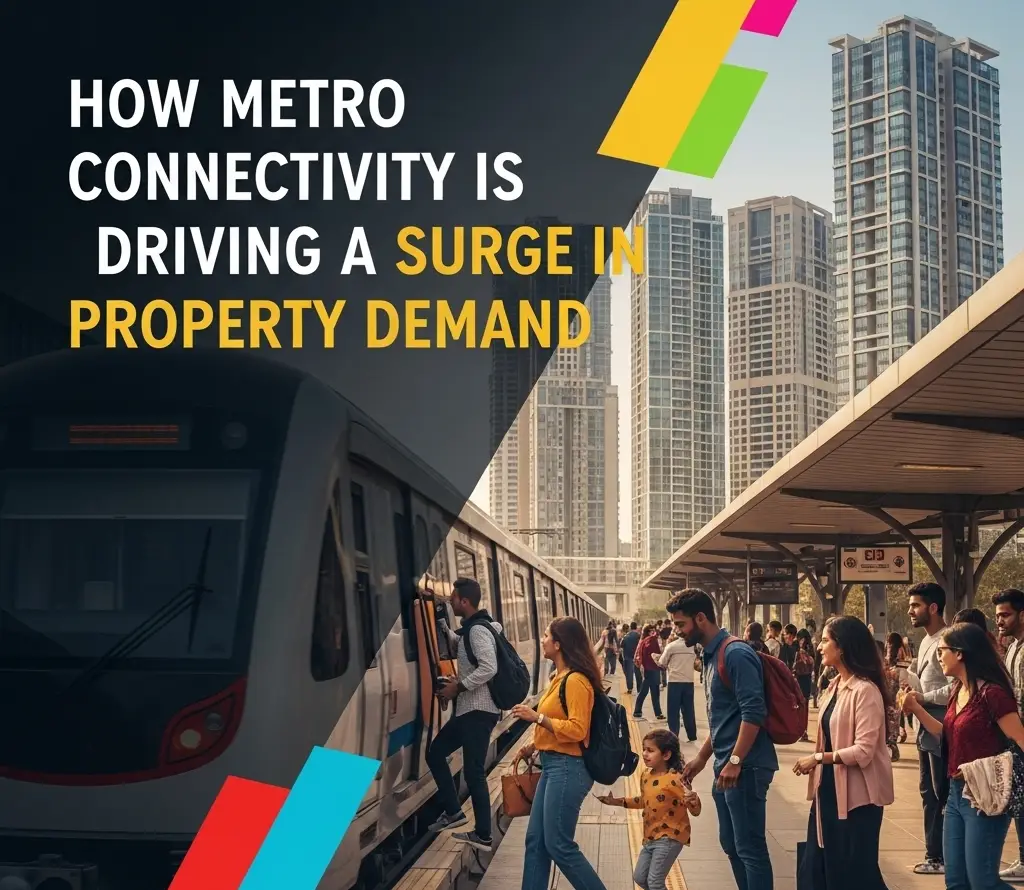Mumbai and Navi Mumbai have seen a real-estate revolution that is not centred on skyscrapers, but rather rail lines. With the launch of Mumbai Metro Line 3 (Colaba-Bandra-SEEPZ) and Navi Mumbai Metro Line 1 going live in November 2023, property demand is shifting toward mobility-linked micro-markets. These nodes are not fringe locations, but vibrant new-age nodes. Homebuyers are now more concerned with accessibility, lifestyle and a reduced commute. The article shows how the proximity of metro stations has changed demand. The article also highlights which neighbourhoods are most affected by this urban shift and provides tips to buyers on how to deal with it.
Impact of Mumbai Metro on Real Estate.
Line 3 – BKC to Worli corridor, launched in late 2024, sparked a market movement. A month after the Line 3 launch, rents in Mahim Dadar and Sion rose by 2.3%. According to experts, the corridor’s value could increase up to 10-15% in the next 12-18months.
The addition of lines 2A and 7 to Dahisar East & Andheri East has resulted in a 15-20% increase in prices for Borivali and Kandivali. These suburbs, which were previously considered to be far-flung, are now the first choice among middle-income buyers due to their improved infrastructure and fast connectivity.
The appeal is mathematical. The appeal is mathematical.
Navi Mumbai’s Transformation: Metro Line 1 and Beyond
Navi Mumbai Metro Line 1 will be operational by November 2023. (Belapur-Pendhar). The Navi Mumbai Metro Line 1 will be operational in November 2023 (Belapur to Pendhar).
Other Infrastructure Catalysts
- The Mumbai Trans Harbour Link, which connects South Mumbai with Ulwe/Panvel within 20-25 minutes, has resulted in a rise in property values of between 20-25% on the newly developed corridors.
- The Gold Line, the Panvel-Karjat Rail Corridor, and Ulwe Seawoods are expected to increase demand in Panvel, Ulwe Seawoods and Vashi, and other nearby zones.
These upgrades to Navi Mumbai’s infrastructure make it a well-connected and affordable real estate hub. It is a cheaper alternative than the central MMR property market.
Why metro-adjacent homes cost more
Why buyers prefer buying near the Metro:
- Commute efficiency: The typical journey time is reduced by 40-60%. This enables a better integration of work and life.
- Capital appreciation: A property within a radius of 500 meters can command a 10-20% higher value. Due to an increase in tenant demand, rents for apartments connected by metro are 15-20% higher.
- Built Ecosystems: Metro corridors attract retail, schools, and coworking, improving liveability.
- Urban Pocket Planning – Mixed-use and walkable precincts not only provide shortcuts but also add value to lifestyle.
Emerging Hotspots of Mumbai & Navi Mumbai
The following are areas that are growing in popularity:
- Mumbai Metro Zones: BKC, Dadar, Mahim, Andheri, Ghatkopar Zones on Lines 2, 2A, and 7.
- Infrastructure-led Growth Benefits Thane & Western Suburbs, including Mira Road and Bhayandar, as well as the Regions Along Proposed Lines 5 & 9
- Navi Mumbai – Kharghar, Belapur, Taloja and Ulwe, all supported by MTHL and the upcoming Airport. These areas are among the most affordable and fastest-growing real estate markets in Mumbai.
Warnings and Risks
Even though the growth appears promising, buyers must be aware of certain risks.
- Construction Disruption: Noise, dust, and temporary inconveniences may affect living conditions in the short term.
- Inventory glut: Speculative investment may lead to a surplus of inventory in metro corridors.
- As the value of zones increases, buyers who earn a middle income could find it difficult to afford their homes.
- The demand may fluctuate while lines like Metro 6 and Airport Express remain unfinished.
To make the right decisions, you should consider more than just proximity to stations. You also need to take into account amenities such as infrastructure and follow-up.
Conclusion & Forward Outlook
Mumbai’s and Navi Mumbai’s metro infrastructure is not just easing commutes; it’s redefining real estate logic. The connectivity, from Line 3 and Navi Metro 1 to supporting infrastructure like MTHL and new residential hubs, is reviving the demand and broader growth areas.
Metro lines are a valuable asset for homebuyers and investors.
Areas such as Thane and Mira Road Panvel, and Seawoods will likely become focal points when corridors like Thane-Bhiwandi and the Gold Line, Metro 6 and Metro 6 are operational. Your next real estate investment could be the line of transit.
FAQs
Q1. How can I expect to be greeted by a new Metro corridor in the future?
In the first year, property adjacent to metro lines like Line 3 in Mumbai and Line 1 in Navi Mumbai typically appreciates by 10-15%.
Q2. Do rental yields rise near metro stations?
Yes. Tenants prefer connectivity—leading to 15-20% higher rental opportunities in metro-adjacent neighbourhoods.
Q3. Is it better to invest in Metro before or after the launch of Metro?
Buying early can often be a good investment, as price increases start during the construction and announcement stage.
Q4.What neighbourhoods have a balance between affordability and growth?
The best value for money is Mira Road (Ulwe), Kharghar and Belapur. They all offer relative affordability in areas with good transit links.
Q5. Which lines should investors be watching?
- Metro Line 6 (Andheri – Vikhroli) & Gold Line (CSMIA – Navi Mumbai Airport) – major future value drivers
- The expansion and upgrading of the MTHL rail line, Panvel-Karjat, will boost growth in peripheral areas.


Write Your Comment